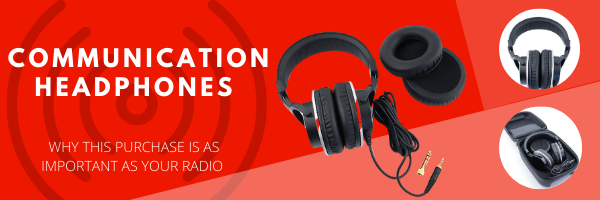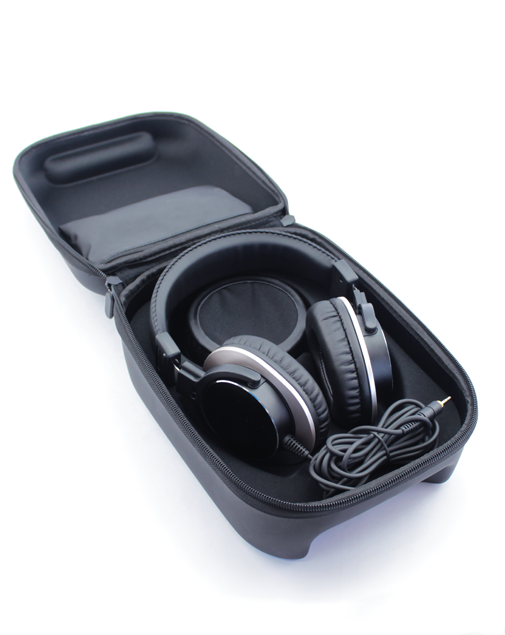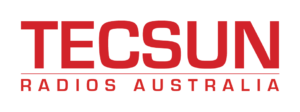
Shortwave radio listening is a hobby that allows you to fully immerse yourself in a separate world of international events. From listening to a shortwave broadcast station, long-distance aircraft travelling around the world or even international amateur radio operators, this hobby allows you instant access, to the exclusion of those physically around you.
To further enhance the listening experience, a good set of comfortable headphones is essential. Communications headphones, as distinct from those used for Hi Fi listening, need to be comfortable to wear for hours on end. At the same time, they need to be able to reproduce the full audio spectrum produced by the receiver, ensuring that even weak signals can be resolved adequately. Wired, over the ear headphones also have the advantage that there are no batteries to replace, contrary to Bluetooth and noise-cancelling headphones.
Another important requirement for a good pair of communications headphones is a long connection cable. Most Shortwave Listeners and amateur radio operators have their equipment set up on a bench or desk, which is often multifunctional. With adequate cable length (at least 2 metres), there is room to move around the “shack”, doing other things whilst maintaining a connection with the receiving source.
If you are going to invest in a good quality pair of headphones, it is important to be able to keep them in a safe place where they won’t get damaged and will be kept clean. A carry case is ideal for this, and this can also be used to keep any necessary audio adaptors (3.5-6.3mm adaptor to cater for all receiver types, for instance), and spare ear muffs with your headphones.
Here at Tecsun Radios Australia, we have held off selling headphones until we tested several on the market first to find the most suitable high quality headphones for shortwave listening.
Launching on Friday January 29 2021 we are proud to showcase the exceptional Tecsun Radios Australia communications headphones that have been specially selected with user comfort in mind. This is essential for long periods of shortwave listening.

To read more about these communication headphones click here.

The thing about emergency kits is you don’t need them till you do. As the name states, “Emergency”
Meaning: A serious, unexpected, and often dangerous situation requiring immediate action
Having a prepared Emergency Kit on hand, filled with items that will help you survive a bushfire or natural disaster, easily accessible and ready to go will not only give you peace of mind but may also save your or someone else’s life.
A good kit will equip you whether you are staying in your home or have to evacuate
With just two weeks left till summer if you haven’t already prepared your emergency kit now is the time.
Pack your items in a watertight dry bag or sealable container and keep it in an easily accessible location in your house, accessible to everyone. Do not store it in a cupboard or wardrobe behind household items, you need to be able to grab this kit and go.
Have a family meeting and show them where it is located and what is inside it. It’s important that absolutely everybody, even kids need to know about this kit. Particularly if parents are injured or not close by.
Storing items within the kit in airtight plastic containers and sealer bags will help keep your belongings dry and in good condition both while in storage and during an emergency situation.
Here is a list of your essential items to pack.
- Flashlight
- Personal medication
- Bandaids, antiseptic and a bandage.
- Bottled water. Allow 2L per person per day minimum.
- Food, non perishable, as required..
- Manual can opener
- Matches in a waterproof container or bag
- Candles
- Cash- if the power is out then the ATMS wont work.
- Phone “power bank”. Make sure it is changed at all times.
- Extra batteries for your flashlight
- Whistle to signal for help
- Dust masks to help filter contaminated air- P2 masks are best for dust and smoke.
- Toilet paper, moist towelettes etc for personal sanitation
- Local maps
- Sharp knife (penknife)
Repack expired items as needed and repack/ check your emergency kit every year. Set a note in your calendar every year to do this.
Don’t have an emergency radio yet?
We recommend the Best Emergency Radio which is our highest performance AM/FM/SW Solar Powered Radio with inbuilt Solar Panel and Hand Crank Dynamo Charging. Additional features much needed during an emergency are an LED torch and personal alarm, a siren to gain the attention of emergency services and an inbuilt USB charger.
We recommend the DE13 Emergency AM/FM/SW Solar Radio which is an economy model, featuring a torch, personal alarm, inbuilt Solar Panel and Dynamo hand crank charger that allow you to recharge the internal battery or charge any device by USB or mini USB including your mobile phone. This is the perfect radio to keep for any emergencies
Click here to shop these products in our online store.

We were delighted to watch this review by Troy & Pascale from Free Range Sailing who are currently exploring our beautiful country in a 30-foot yacht called Mirrool.
Whilst sailing through northern Australia as well as the west coast of Tasmania there are limited coastal stations broadcasting on VHF.
Using a shortwave radio like the Tecsun PL600 was really beneficial for Troy & Pascale to receive up to date weather forecasts, crucial when sailing.
Most meteorological bureaus will publish the times and frequencies ( these change, day/night) that you will be able to pick up the weather schedule via your shortwave radio.
The radio Pascale used was the Tecsun PL600 Worldband radio. At just $129 The Tecsun PL600 World Band Radio is the perfect entry product to the world of shortwave listening and an essential when traveling to isolated areas.
To view the full video click here.
To learn more about the Tecsun PL600 a fantastic entry-level shortwave radio priced at just $129 click here
If you would like to follow Troy and Pascale’s intrepid adventures ( highly recommended) click here


